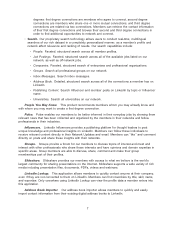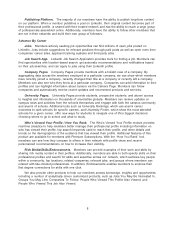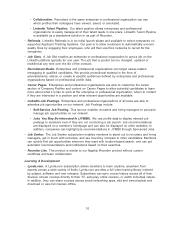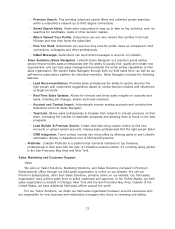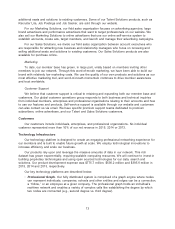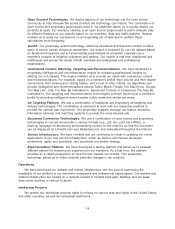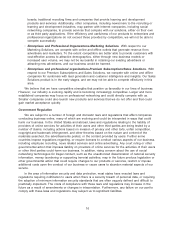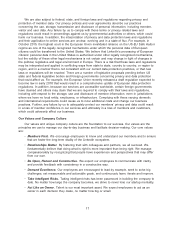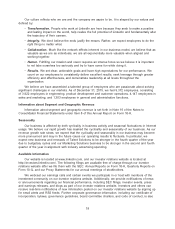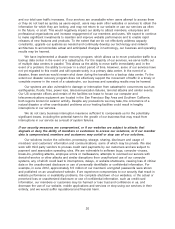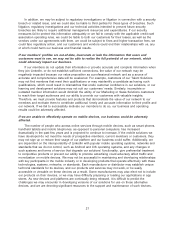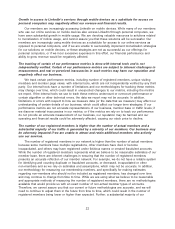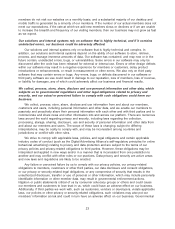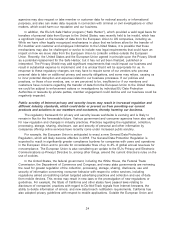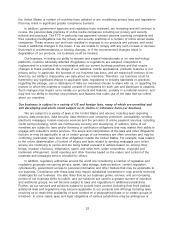LinkedIn 2015 Annual Report Download - page 17
Download and view the complete annual report
Please find page 17 of the 2015 LinkedIn annual report below. You can navigate through the pages in the report by either clicking on the pages listed below, or by using the keyword search tool below to find specific information within the annual report.We also rely on a combination of trade secrets, copyrights, trademarks, trade dress, domain
names and patents to protect our intellectual property. We pursue the registration of our domain
names, trademarks, and service marks in the United States and in many locations outside the United
States. Our trademarks and registered trademarks in the United States and other countries include
‘‘LinkedIn’’ and the ‘‘in’’ design mark, as well as others. We register copyrights in many of our online
training videos. We hold a growing portfolio of issued patents of varied duration in the United States
and internationally, and regularly file patent applications to protect intellectual property that we believe
is important to our business. We believe the duration of our patents is adequate relative to the
expected lives of our products. We seek to protect our trade secrets through a combination of physical
controls and contractual restrictions. For example, we enter into confidentiality and invention
assignment agreements with our employees and contractors, and confidentiality agreements with third
parties.
Circumstances outside our control could pose a threat to our intellectual property rights. Effective
intellectual property protection may not be available in the United States or other countries in which our
products and solutions are distributed. For example, in many countries the protection of database rights
can be limited. Also, the efforts we have taken to protect our proprietary rights may not be sufficient or
effective. Any significant impairment of our intellectual property rights could harm our business or our
ability to compete. Also, protecting our intellectual property rights is costly and time-consuming. For
example, we expect to spend time and resources policing the unauthorized use and streaming of our
online training videos. Any unauthorized disclosure or use of our intellectual property could make it
more expensive to do business and harm our operating results.
Companies in the Internet, social media technology and other industries may own large numbers
of patents, copyrights, and trademarks and may frequently request license agreements, threaten
litigation, or file suit against us based on allegations of infringement or other violations of their
intellectual property rights. From time to time, we face, and we expect to face in the future, allegations
that we have infringed the trademarks, copyrights, patents and other intellectual property rights of third
parties, including our competitors and non-practicing entities.
Competition
We face significant competition in all aspects of our business, and we expect such competition to
increase, particularly in the market for online professional networks and engagement of professionals.
Specifically, we compete for members, enterprises and professional organizations as discussed below.
•Members-professional networks. The space for online professional networks is rapidly
evolving. Other companies such as Facebook, Google, Microsoft and Twitter are developing or
could develop solutions that compete with ours. Further, some of these companies are
partnering with third parties to offer products and services that could compete with ours.
Additionally, we face competition from a number of companies outside the United States that
provide online professional networking solutions. We also compete against smaller companies
that focus on groups of professionals within a specific industry or vertical. Our competitors may
announce new products, services or enhancements that better address changing industry
standards or the needs of members and customers, such as mobile access or different market
focus. Any such increased competition could cause pricing pressure, loss of business or
decreased member activity, any of which could adversely affect our business and operating
results. Internet search engines could also change their methodologies in ways that adversely
affect our ability to optimize our page rankings within their search results.
•Enterprises and professional organizations-Talent Solutions. With respect to our Talent
Solutions, we compete with online recruiting companies, talent management companies and
larger companies that are focusing on talent management and human resource services, job
15




